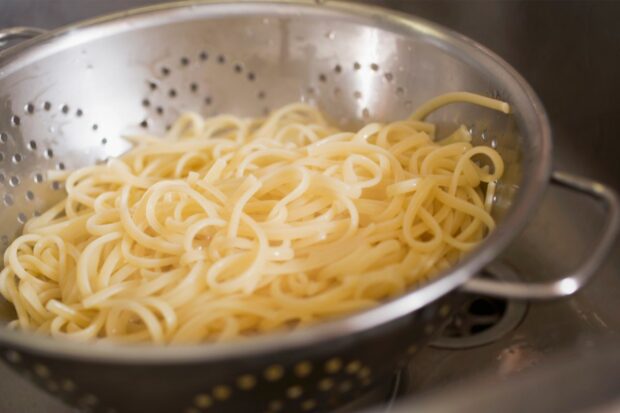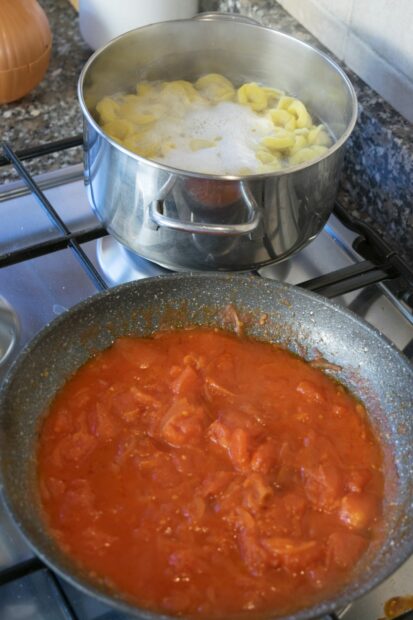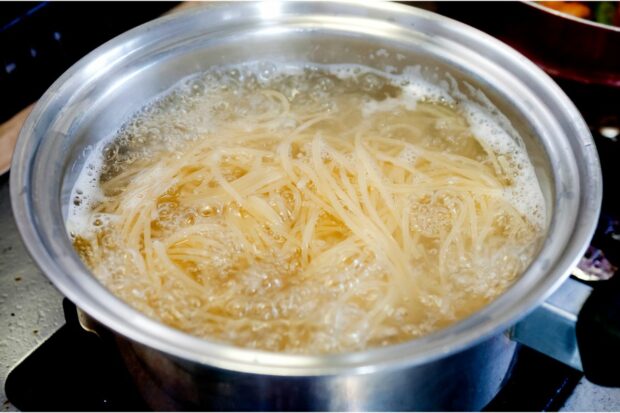You were in a hurry while making pasta and you drained it before it was completely cooked. It happens to the best of us. So what should you do now?
Before you throw out that undercooked pasta, consider the following options for fixing it. . . .

Try To Recook the Pasta
For undercooked pasta, you can always place the pasta back into a pot, fill it up with water, and boil it again. Consider using a lower heat than what you used initially. Boiling partially cooked pasta at a lower heat and for a longer period of time helps it cook more evenly, which is important since some of your undercooked pasta noodles will be more done than others.
Another option is to bring some water to a rapid boil, place the pasta in the water, and check it after 60 seconds. If the pasta doesn’t feel soft enough after 60 seconds, keep boiling and checking it in 60-second intervals until it feels soft enough.
Mix the Pasta With Your Sauce on the Stove
If your pasta sauce is already on the stove cooking, you can throw your undercooked noodles in there and let the two foods cook together. In fact, some chefs actually cook their pasta this way—they skip the step of boiling the pasta and mixing it with the sauce afterward and simply put uncooked pasta into the sauce so they can cook together. While this isn’t recommended for the average person, you can still put your undercooked pasta into your sauce and cook at medium to medium-high heat until the noodles are more tender. For the best results, cook slowly and with the lid on.

Why Is It So Important To Have Fully Cooked Pasta?
Fresh pasta and fresh sauce are delicious, but is it always imperative that your pasta noodles be cooked to a soft texture? Oddly enough, some people actually like the taste of undercooked, slightly chewy pasta noodles. Moreover, pasta may need to be cooked differently if you’ll be using it in a cold dish—for instance, in pasta salad.
The point being, pasta doesn’t have to be fully cooked as a rule. It will always come down to personal preference and the recipe you’re making.

How To Cook Your Pasta Just Right
At this point, you’re probably asking yourself what you can do to make sure your pasta comes out tender, soft, and delicious every time.
For starters, always use a large pot. Pasta needs room to move around in the boiling water to cook evenly. You also need to use the right amount of water. For every pound of pasta, you’ll need five to six quarts of water.
Another tip is to make sure you salt your water. Adding salt to your pasta-cooking water might seem like it’s just for taste, but there’s more to it than that. Salt also makes the pasta more tender and gets it that way faster. For the best results, add 1.5 to 2 tablespoons of salt for every pound of pasta you’re cooking. You should also add the salt—as well as the uncooked pasta—only after the water has come to a rolling boil. Never add either of these items to non-boiling water, or your pasta might stick together.
It’s easy to overcook pasta, so you’ll want to watch your cooking time. If the instructions that come with your uncooked pasta tell you a specific cooking time, you should follow that to the letter. Otherwise, plan to cook a large pot of pasta for 10 minutes, but start checking it after 9 minutes. If possible, stay close to the stove when you’re cooking pasta. It’s just too easy to forget about it and cook the pasta too long.
Finally, you should always drain your pasta noodles immediately after they’re done. If you don’t, the pasta will continue to cook in the hot water even if you take it off of the burner. Once you remove your pasta from the stove, turn the burner off and drain your pasta well, then transfer it into a large bowl or a separate pot. Never put it back into the pot you used to boil the pasta because it could still be hot enough to continue to cook the pasta.
